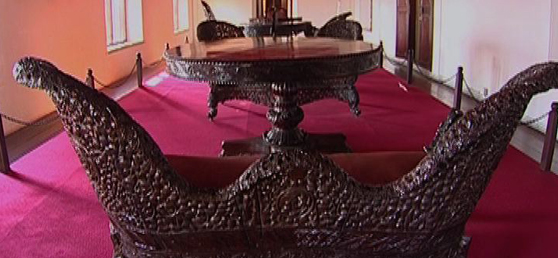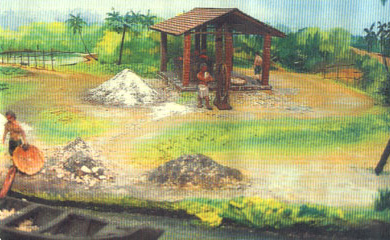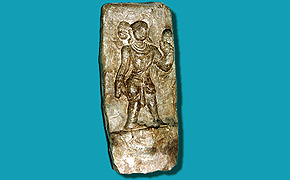|
| Arakkal Kettu |
|
 |

Arakkal Kettu, the
residence of the former Arakkal Ali Rajas, the only Muslim royal
family of Kerala is located 3 km from Kannur town.
Kizhunna Ezhara Beach:This beautiful stretch of sand is one of the most secluded beaches located 11 km from Kannur town in Kerala.
|
|
| Water Resources Museum, Kunnamangalam |
|
 |

A drop of water becomes part of many forms; rain, snow, rivers,
lakes, seas, oceans and the like. How much precious is water to us? Its
true value will only be realized when water becomes a rare commodity or
when it becomes no more part of our surroundings.
And to emphasize
the immense value of water in our daily lives and those depend on it
equally for survival, like plants and animals, a museum dedicated to
water is about to come up at Kunnamangalam in Kozhikode. The upcoming
'Water Heritage Museum' highlights the significance of water in relation
to man and and also its usage in day-to-day life, with special emphasis
of Kerala's traditions involving the use of water.
The museum, slated for opening in three month's time at Kunnamangalam
in Kozhikode District is an initiative by the Centre for Water
Resources Development and Management (CWRDM). As per the authorities,
the upcoming museum for water has interesting displays in the form of
pictures, statutes, still life etc. Driven by the imagination of the
scientists and other staff of the CWRDM, their concepts got transformed
with the help of painters, sculptors and other artistes, who made use of
clay, plastic, hay, plaster of Paris, wax and also waste material.
The entrance to the museum itself has a touch of traditional
Malayalee hospitality in the form of Padipura, which is a form of
multipurpose entrance, once used to be a symbol of houses belonging to
aristocratic families of Kerala. Near the entrance, one would also find a
3.5 mtr high statue, depicting the theme 'The earthward descend of
River Ganga'.
Some of the attractions inside the upcoming Water Heritage Museum is
the display, featuring a Malayalee woman, drawing water from a well,
located close to the kitchen. A phenomenon that one could associate with
houses, especially in rural Kerala. The water wells are located in the
northeastern corner of the house, and very close to the kitchen. This
location of the well has significance, as it is believed to enhance
wealth, divine grace and also happiness in the household.
The significance that water has as part of religious practices is
also highlighted in the water museum. Also finding place in the museum
are still models and paintings, enlightening visitors on the various
methods used by Keralites for irrigation, since ancient times.
Associated with these methods are names like Surangam, Thulathekku,
Chakram, Pettiyum Parayum, Kenikal etc.
The Canoli Canal that contributed to the commercial advancement of
Kerala and Idukki Hydroelectric project are some of the other exhibited
items at the water museum in Kozhikode. The unique relationship of water
and the State of Kerala is further highlighted in the section depicting
the lifestyle and activities of the waterlogged region of Kuttanad,
which is one of the rice bowls of Kerala. Similar geographical settings,
where water dominates in shaping up the lives of people like the
backwaters of Vembanad and the Kole wetlands gets due attention in the
Water Heritage Museum at Kunnamangalam.
Another interesting section of the water museum that invites the
visitors' attention are the displays, highlighting various traditional
agrarian practices of Kerala. And this includes the method of Pokkali
farming, making of coir, lime shell harvesting, inter cropping, mixed
farming, harvesting seasons of Kerala and others.
When one mentions about water and Kerala, River Nila, popularly known
as Bharata Puzha occupies a special place in the hearts of Keralites.
This river, which has been a source of inspiration for those living by
the banks and also to writers in Malayalam literature to come up with
outstanding literary works, finds a special place in the upcoming water
museum. The museum has displays pertaining to literary personalities and
scientists associated with River Nila, as well as traditional teaching
centers like Alathiyur, Thrikandiyur, Ezhuthumadam etc.
With some bare facts on water and featuring the unique, traditional
usage of water by Keralites, the upcoming water museum in Kozhikode is
sure to provide its visitors an interesting time. So, do make it part of
your travel itinerary, the next time, while you are in Kozhikode.
Contact Telephone: +91- 495- 2357151
Getting there:
Nearest railway station: Kozhikode, about 15 km away.
Nearest airport: Karipur airport, about 33 km away
|
|
|
|
|
| Ambalavayal Heritage Museum |
|
 |

Location:12 km south of Sulthan Bathery, Wayanad district.
Visiting hours: 10:00 am to 5:00 pm.
Attractions: Rare 2nd century artefacts.
The Ambalavayal Heritage Museum, the archaeological museum in
Wayanad, has one of Kerala's largest collections of the remnants of an
era dating back to the 2nd century A.D. The exhibits here are
evidences of an advanced civilisation that existed in the mountains of
Wayanad. The articles on display are a fascination for the historian,
the archaeologist and the ordinary man alike. At the museum you can
see articles as varied as clay sculptures, ancient hunting equipments
like bows and arrows, stone weapons and other curios.
Getting there: Sulthan
Bathery, the nearest town, is about 98 km from Kozhikode city.There
are frequent bus services between Sulthan Bathery and Kozhikode.
Nearest railway station: Kozhikode, 97 km from Sulthan Bathery.
Nearest airport: Karipur International Airport, Kozhikode about 120 km from Sulthan Bathery. |
|
|
| Pazhassiraja Museum & Art Gallery |
|
 |

Location: About 5 km from Kozhikode town at East Hill, Kozhikode district, North Kerala.
Open: 9 a.m. - 4.30 p.m. Break: 1 p.m. - 2 p.m. Closed on Mondays and other public holidays. Ph: +91 - 495 - 2384382
A veritable treasure trove for historians and connoisseurs of art, the
Pazhassiraja Museum is located in Kozhikode - the land of
spices which lured navigators from time immemorial down to the
Portuguese explorer Vasco da Gama in 1498. The Art Gallery
adjacent to the museum displays the acclaimed paintings of
Kerala's cherished artists, Raja Ravi Varma (1848 - 1906)
whose works brought international repute to the State and his
uncle Raja Raja Varma.
The museum is managed by the State
Archaeology Department and has on display mural paintings,
antique bronzes, ancient coins, models of temples, umbrella
stones, dolmenoid cists (quadrangular burial chambers with
capstones), and similar megalithic monuments. For more
information on Ravi Varma's works, refer 'The prince among painters
and a painter among princes' .
The museum and the art
gallery are named after the great Pazhassiraja Kerala Varma of
the Padinjare Kovilakom of the Kottayam royal family. The
famous 'Pazhassi Revolt' (against the British East India Company
during the second half of the 1700s) was led by Pazhassiraja.
Nicknamed the Lion of Kerala, Pazhassiraja is also
credited with introducing guerilla warfare in the hills of
Wayanad to resist the increasingly intolerable British
colonialism. This great freedom fighter was shot dead in an
encounter on 30 November 1805.
Getting there:
Nearest railway station: Kozhikode.
Nearest airport: Karipur International Airport, Kozhikode about 23 km from Kozhikode town. | | | | |
|
|
|
|
No comments:
Post a Comment